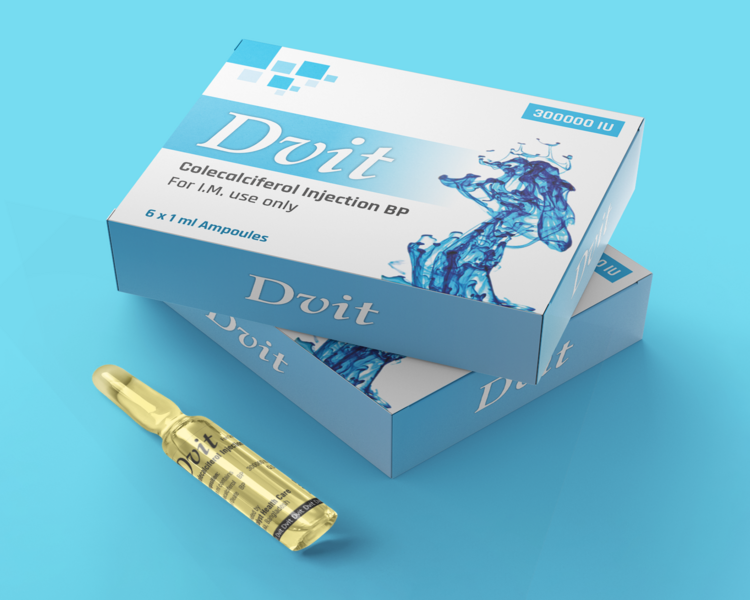DVIT-CHOLECALCIFEROL INJECTION BP 300000 IU

COMPOSITION:
Each ml contains
Cholecalciferol BP 300000 IU
Ethyl oleate BP Q.S.
PHARMACOLOGY:
Vitamin D regulates the calcium- and phosphate balance. Cholecalciferol and to an even greater extent its hydroxylation products induce the formation of a calcium transport protein in the mucous membrane of the small intestine. This leads to increased absorption of calcium and phosphate from the intestine. In the kidneys vitamin D stimulates the reabsorption of calcium and phosphate. A vitamin D deficiency leads to rickets in the growing organism and osteomalacia in adults.
PHARMACOKINETIC:
Absorption: Colecalciferol is easily absorbed from the gastrointestinal tract in the presence of bile. In case of reduced fat absorption, the absorption of vitamin D is also reduced.
Distribution: Colecalciferol can be stored in adipose- and muscle tissue for a long time. The effect of cholecalciferol starts slowly and is long lasting effect. Its half-life is 19-25 hours.
Metabolism: The active form of Colecalciferol is 1,25-dihydroxycholecalciferol, which is formed by hydroxylation of cholecalciferol in liver and kidneys.
Elimination: Colecalciferol and its metabolites are excreted mainly in the bile and faeces. Small amounts appear in the urine.
INDICATIONS:
Dvit Injection is indicated in:
- Prevention and treatment of vitamin D deficiency
- Treatment of rickets
- As an adjunct to a specific therapy for osteoporosis in patients at risk of vitamin D deficiency
POSSIBLE SIDE EFFECTS:
Nausea, loss of appetite, weight loss Hypocalcaemia, hyperkalemia, Constipation, flatulence, nausea, stomachache, diarrhea.
CONTRAINDICATIONS:
Hypersensitivity to the active substance or to any of the excipients. Hypercalcemia and Hypercalciuria
PREGNANCY & LACTATION:
Cholecalciferol should not be used during pregnancy or lactation if necessary.
However it is preferable to consult your doctor before using this drug.
DOSAGE & ROUTE OF ADMINISTRATION:
Rickets: 1 ampoule every 2 weeks for one month then 1 ampoule for every 4 months.
Osteoporosis: 1 ampoule every 2 weeks for 3 months.
Osteomalacia: 1 ampoule every 2 weeks for 3 months.
Tetany caused by hypocalcemia: 1 ampoule for every 4 months which may be increased to 2 ampoules.
Renal Osteodystrophy: 1 ampoule daily or advised by the physician.
Menopause: 1 ampoule for every 6 months.
Preventive measures: Pregnancy: 1 ampoule every at 6th or 7th month.
During breast feeding: 1 ampoule for every 6 month.
Children upto 6 years: 1 ampoule for every 6 month.
Adolescent & Elderly: 1 ampoule for every 6 month.
Renal impairment:
In cases that require continuous use of vitamin D3, kidney functions should be controlled. It should not be used with calcium in case of severe kidney failure.
Hepatic impairment:
No data is available.
Method of administration:
Cholecalciferol ampoule is used oral and intramuscularly
DRUG INTERACTION:
Mineral oils reduce the absorption of vitamin D, reducing the effect of Cholecalciferol
Phenytoin, barbiturates, and rifampicin may reduce the effectiveness of vitamin D3 as they induce hepatic microsomal enzymes.
SPECIAL PRECAUTIONS FOR USE:
- Vitamin D should be given with caution in patients with sarcoidosis and other granulomatous
disorders due to the risk of increased metabolization of vitamin D to its active form. These
patients should be monitored for the calcium content in serum and urine.
- Serum calcium levels should be monitored in children with known hypercalcemia.
- In long-term treatments, renal and urinary calcium levels and serum creatinine measurement should be checked every 3 to 6 months. These controls are particularly important in elderly patients and in concomitant treatment with cardiac glycosides or diuretics.

